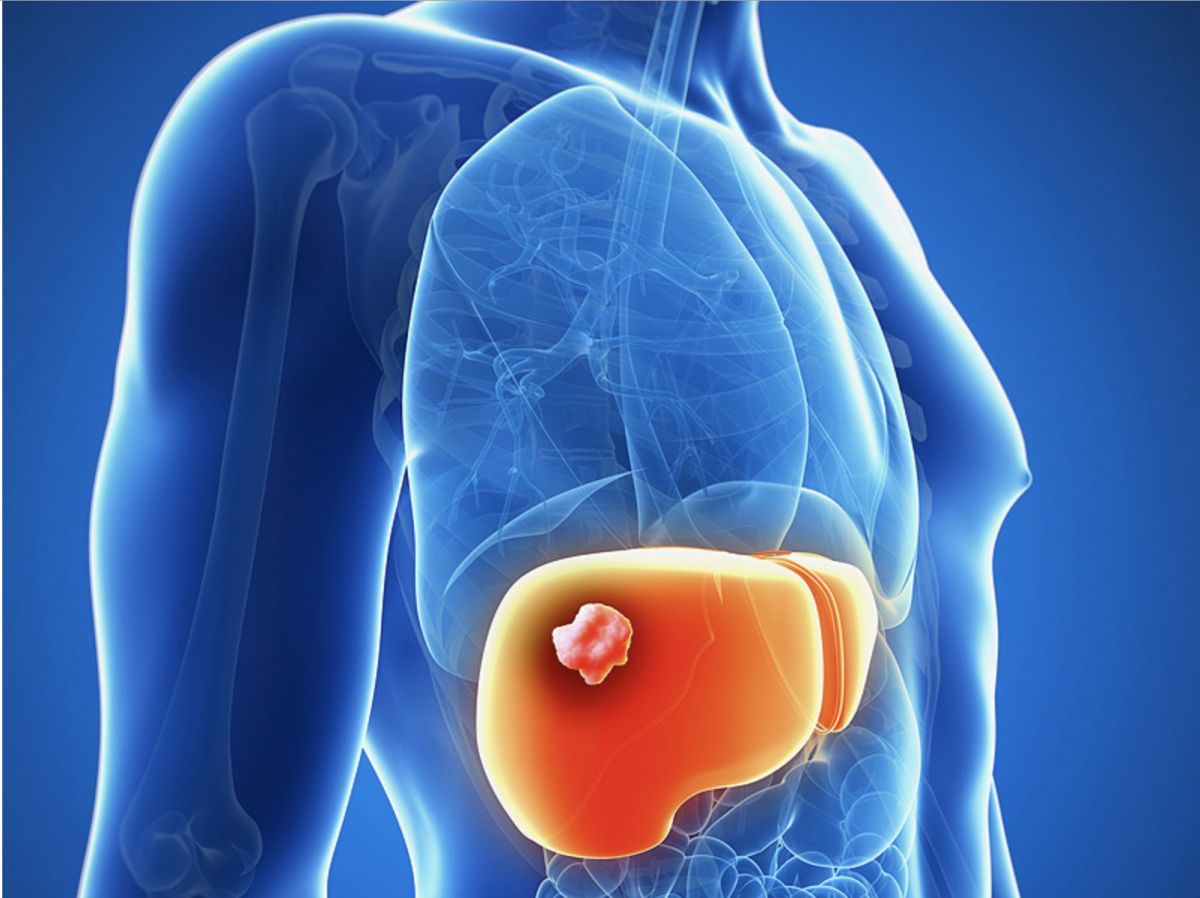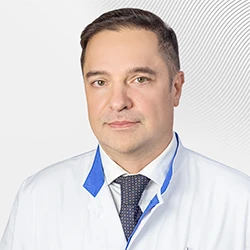Liver cancer
 Depending on the origin of the tumor, primary and metastatic liver cancer are distinguished. Secondary or metastatic liver cancer is much more common – in European countries and the United States, it is on average 20 times more common than primary cancer.
Depending on the origin of the tumor, primary and metastatic liver cancer are distinguished. Secondary or metastatic liver cancer is much more common – in European countries and the United States, it is on average 20 times more common than primary cancer.
Liver cancer metastases require a different treatment approach than primary liver cancer.
The most common type of primary liver cancer is hepatocellular carcinoma, which develops from liver cells called hepatocytes. Cholangiocarcinoma (cancer of the bile ducts) and angiosarcoma are less common.
Liver cancer treatment at the EMC Institute of Oncology, Moscow
-
Highly qualified doctors from the USA, Europe, Israel, and Russia.
-
Interdisciplinary approach: the treatment tactics of each patient are determined at an oncological consultation with the participation of oncologists, oncological surgeons, morphologists and radiotherapists.
-
All the most modern diagnostic methods: CT, MRI, PET/CT; biopsy under ultrasound, CT and MRI control.
-
Treatment is carried out according to protocols recommended by the American and European Cancer Societies (NCCN, ESMO).
-
The entire volume of radical and palliative surgeries for liver cancer (oncologists, specialists in the field of liver tumor surgery.
-
Targeted therapy of liver cancer with Sorafenib.
-
Radiosurgery for the treatment of primary liver cancer and liver metastases is the exposure of a tumor to a focused high–intensity beam of radiation.
Risk factors for primary liver cancer
Men are more likely to develop primary liver cancer. As a rule, the disease develops at the age of 50-65 years.
The main risk factors for liver cancer:
-
Cirrhosis, chronic hepatitis B and C
-
Non-alcoholic fatty liver disease (fatty hepatosis)
-
Hemochromatosis
-
Type 2 diabetes
-
Primary biliary cirrhosis (autoimmune liver disease).
Other risk factors:
-
Heredity (cases of primary liver cancer in close relatives)
-
Taking anabolic steroids for a long time
-
Aflatoxin Exposure;
Symptoms of liver cancer
Unfortunately, like most oncological diseases, liver cancer is asymptomatic at an early stage. As the disease progresses, symptoms such as:
-
Loss of appetite and rapid satiety
-
Weight loss for no apparent reason
-
Nausea and vomiting
-
Constant fatigue, weakness, poor health
-
Persistent or intermittent pain in the liver area
-
Increased temperature
-
Abdominal enlargement due to fluid accumulation (ascites)
-
Jaundice of the skin and whites of the eyes
Patients at risk with chronic liver diseases (chronic viral hepatitis, cirrhosis of the liver) should be regularly examined by a therapist and a hepatologist at least once every six months. The EMC Hepatological Center provides comprehensive diagnostics and therapeutic treatment for patients with liver diseases of any severity. At the EMC Institute of Oncology, patients at risk of developing liver cancer can undergo a specialized oncological check-up.
Liver cancer diagnosis
Diagnosis begins with an examination by a doctor (hepatologist) or gastroenterologist, who conducts the examination and can prescribe the following tests:
Blood tests, including liver tests (ALT, AST, GGT, alkaline phosphatase, total bilirubin) and alphafetoprotein (AFP) test. AFP is a tumor–specific marker for hepatocellular carcinoma, but its level may increase in hepatitis, other liver diseases, and other tumors.
-
Laparoscopy (endoscopic surgery)
-
Liver biopsy
Liver biopsy is a safe procedure if it is performed by an experienced specialist. The incidence of severe complications, the most serious of which is bleeding, is no more than 1%.
A liver biopsy is performed at the EMC under the supervision of ultrasound and computed tomography, which ensures high accuracy and safety of the procedure. Puncture biopsies under CT control are performed by the Deputy Medical Director for Radiation and Isotope diagnostics, a specialist in the diagnosis of oncological diseases, Professor Evgeny Libson (Israel).
The obtained material is sent to the EMC Histological Laboratory to establish the diagnosis and determine the characteristics of the tumor necessary for choosing the right treatment tactics. If necessary or at the request of the patient, the diagnosis is verified in leading clinics in the USA, Great Britain, Israel, Germany, France, Switzerland.Getting a "second opinion" from a foreign specialist is included in the standard cost of the study.
Histologically, hepatocellular cancer can range from highly differentiated (with individual hepatocytes that look almost like normal liver cells) to low-differentiated, consisting of large multinucleated anaplastic tumor cells.
Liver biopsy is not always necessary. In some cases, the diagnosis of hepatocellular cancer is established on the basis of instrumental research methods (CT or MRI), which detect tumor vascularization typical of cancer, if the patient has high AFP values (more than 500 ng/ml).
Stages of liver cancer
Stages of hepatocellular cancer:
-
Stage 1 — a single tumor with no vascular invasion, no lesion, and distant metastasis
-
Stage 2 — a single tumor with vascular invasion, or multiple lesions of no more than 5 cm, without lesion of the left side, and distant metastasis
-
Stage 3A — multiple tumors over 5 cm, without lesion of the left side, and distant metastasis
-
Stage 3B — tumors of any size with spread to the portal or hepatic veins, without lesion, and distant metastasis
-
Stage 3C — tumors with spread to other organs (except the gallbladder), or with damage to the visceral peritoneum
-
Stage 4A — any tumor with lymph node involvement, without distant metastasis
-
Stage 4B — any tumor with distant metastasis
Stages of cholangiocarcinoma:
-
Stage 1 is a single tumor with no vascular invasion, no lymph node damage, and no distant metastasis.
-
Stage 2 is a single tumor with vascular invasion, or multiple lesions, without lymph node damage, and distant metastasis.
-
Stage 3 — the tumor spreads to the visceral peritoneum or neighboring structures, without damage to the lymph nodes, and distant metastasis.
-
Stage 4A — periductal invasion, without lymph node damage and distant metastasis; or any primary tumor with lymph node damage.
-
Stage 4B is a tumor with distant metastases.
Hepatocellular carcinoma metastases
At the time of diagnosis, extrahepatic metastases are found only in 5-15 percent of cases. They are more common in patients with a progressive stage of the disease with a tumor larger than 5 cm and in the presence of vascular invasion (involvement of the vascular wall in the tumor process). Distant metastases of hepatocellular cancer are most often found in the lungs, intra-abdominal lymph nodes, bones, and adrenal glands.
In liver cancer, the level of liver damage is also assessed on the Child-Pugh scale, especially in patients with cirrhosis. Depending on the degree of ascites accumulation, serum concentrations of bilirubin and albumin, prothrombin time, and the degree of encephalopathy, the following degrees of liver damage are distinguished:
-
Class A (well-compensated disease) - 5-6 points;
-
Class B (poorly compensated) - 7-9 points;
-
Class C (decompensated disease) - 10-15 points.
These classes correspond to the one- and two-year survival rates of patients:
-
Class A: 100 and 85 percent;;
-
Class B: 80 and 60 percent;;
-
Class C: 45 and 35 percent.
Liver cancer treatment
At the EMC Institute of Oncology, each case is reviewed in an interdisciplinary consultation with the participation of an oncologist, surgeon, histologist, radiotherapist and, if necessary, other specialists, and the patient's treatment tactics are jointly determined.
Treatment of liver cancer depends on the location and size of the tumor, the number of growths, the spread of the tumor beyond the organ, whether important blood vessels are affected, and how well liver function is preserved.
The EMC Institute of Oncology provides comprehensive treatment of liver tumors, including:
-
Surgical treatment
-
Transarterial chemoembolization
-
Targeted therapy
-
Chemotherapy
-
Radiation therapy and radiosurgery
Surgical treatment
The most effective treatment for liver cancer is surgery.The EMC performs a full range of surgical procedures on the liver: from the placement of stents in the bile ducts to relieve jaundice to laparoscopic atypical liver resections, as well as the most complex operations — extended hemihepatectomies (removal of 2/3 of the liver). Operations are performed using all existing modern technologies, including the prevention of bleeding and bile flow.
EMC provides radical and palliative treatment for liver cancer:
-
Radical: laparoscopic liver resections, hemihepatectomy (removal of the liver lobe) and extended hemihepatectomy (removal of 2/3 of the liver) are most often performed in liver cancer
-
Palliative: performing HCG and installing stents in the bile ducts in cases where the tumor is an obstacle to the outflow of bile.
Advantages of surgical treatment
-
the use of the most modern technologies, such as high-frequency coagulation, ultrasound destruction, the use of modern means of preventing bleeding and bile flow.
-
The operations are performed by Daniel Viktorovich Podluzhny, PhD.
Patients who do not require surgical treatment or liver transplantation are offered local non-surgical methods of influencing the tumor (transarterial chemoembolization, radiation therapy) and systemic therapy.
Chemoembolization
Chemoembolization is the administration of drugs directly into the vessel feeding the tumor in order to stop the growth of the formation and reduce its size. Chemoembolization is performed through a small incision in the skin by inserting a catheter into the femoral artery. The procedure is performed by an X-ray endovascular surgeon in an angiographic operating room. Chemoembolization can be performed either independently or in combination with other treatment methods.
Radiation therapy for liver cancer
The EMC Radiotherapy Center uses stereotactic radiosurgery SBRT (a modern type of radiation therapy with high single doses in 3-5 sessions) or classical fractionation radiation therapy (30 sessions) for the treatment of both primary (hepatocellular liver cancer and cholangiocarcinoma) and metastatic liver tumors in unresectable patients.
SBRT and classical fractionation radiation therapy are noninvasive treatments for liver tumors that are well tolerated by patients and have minimal side effects. Radiation therapy for severe pain also has a palliative purpose.
Why the EMC
The first and only clinic in Russia, created in the image of the world's leading clinics
EMC is a multidisciplinary center offering patients a high level of medical services and a personalized approach
Worldwide recognition and awards
 Learn more
Learn more
Worldwide recognition and awards
 Certificates and licenses
Certificates and licenses
Make an appointment for a consultation
Specify your contacts and we will contact you to clarify the details
Reviews
and new products of the EMC



.webp)
















